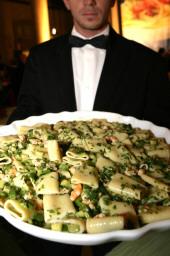Italians are eating more healthily than 30 years ago, Italian food industry federation Federalimentare said Wednesday.
The daily intake of calories per person has dropped from 3,000 kcal to 2,200 kcal since the 1980s, with Italians spurning fats, animal proteins and wine, according to a new report by the federation.
Italy is the largest European consumer of pasta (28 kg a head annually) and cereals (122 kg) and second only to Greece in the consumption of fruit and vegetables, with the average Italian chomping through 360 kg a year.
Federalimentare said the high consumption of fruit and vegetables was partly the result of a boom in frozen products as well as the sale of ready washed and prepared fresh produce, bought regularly by 43% of Italians.
The consumption of fish has risen from 13 kg a head in the 1980s to 21 kg, also thanks to the increased availability of frozen products.
While Italians drank around 16 litres of alcohol annually 30 years ago, this has dropped to an average of 6.9 litres each, according to Federalimentare.
Italians are also likely to deny themselves dessert, according to the report: Italy has the lowest consumption of sweet foods in Europe, at 25.5 kg a year each compared to 58.5 kg in the United Kingdom.
But the federation noted that Italy was also bottom among European milk-drinkers, with Italians drinking 57 litres a year each compared to an average of 93 litres elsewhere on the continent.
The low-fat, high-fibre Mediterranean diet has long been considered one of the best recipes against health problems such as arthritis, obesity, diabetes, asthma and cardiovascular disease.
But the Federalimentare report comes a month after Italy's Higher Health Institute (ISS) revealed that one in three Italian children between the ages of six and 11 are overweight.
The ISS blamed the phenomenon on inappropriate diet and meal habits as well as a lack of physical activity.










